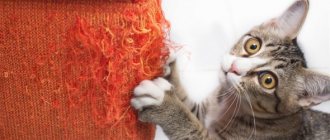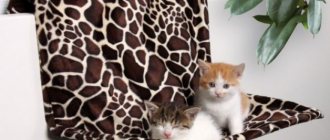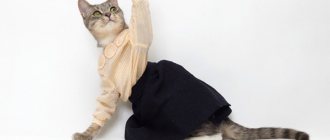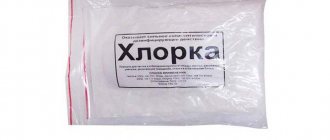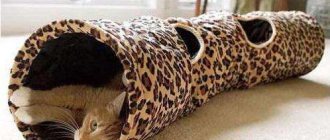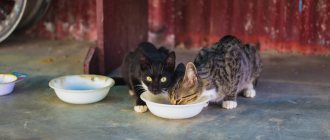Good afternoon
Regardless of whether you want to make a scratching post yourself, buy it in any store, or buy a unique scratching post from us - just 5 short tips on how to make the right choice.
In this article we will talk about what parameters to choose a scratching post for your cat. The choice of parameters largely determines whether the cat will use the scratching post or whether you will simply throw money away and the scratching post will turn into a dust collector. Let me make a reservation right away: in this article we do not touch on the topic of houses and play complexes, although some of the statements are true for them. This article will focus on classic, mostly compact and functional scratching posts for wall or floor placement. So, a short review of scratching posts especially for you.
Briefly about choosing a scratching post (pay attention to the basic parameters):
- The size of the scratching post (the larger the better, even if you have a kitten);
- Manufacturing materials (hypoallergenic, dielectric (do not accumulate static electricity), natural, non-traumatic, materials leaving a minimum amount of fibers (garbage);
- Attracting a cat (treatment with herbs or special mixtures that attract a cat);
- Type of fastening (floor with or without anti-slip feet, wall with hidden or open fastenings, possibility of installation in other places);
- Shape and design (no risk of injury, suitable for the interior).
Now, in more detail about each point:
Scratching post dimensions
The main rule when choosing the size of a scratching post: the width and height of the scratching post should not be smaller than the cat. It is better if the scratching post is larger. Even if you purchased a small kitten, immediately buy a large scratching post. This is due to the convenience for the cat, for example, if the scratching post is narrow, then the cat will be able to sharpen its claws on only one paw and, with a high degree of probability, the cat will not be interested in such a scratching post.
Size factor when placing the scratching post on the floor:
If you observe the cat’s behavior, you can see that for a more reliable support, he places his backside on the scratching post, rests on it with his hind paws, and actively sharpens his claws with his front paws. If the scratching post is smaller than the cat, then he simply will not be able to do this; the scratching post will bounce and sharpening the claws will be problematic.
Size factor when placing the scratching post on the wall:
When a cat sharpens its claws on a vertically placed scratching post (usually on the wall for a classic scratching post or on the floor for a “Column” scratching post), it bends its entire body and stretches its front paws towards the surface. If the scratching post is smaller than the width of the cat, the cat will be uncomfortable.
Yami-Yami scratching post - the best scratching post for cats
The classic model is a compact flat board that can be placed on the floor or attached to the wall. It takes up minimal space in the apartment and is convenient to take with you on trips. The board is upholstered in durable natural jute. Jute is a coarse rope made from plant fibers.
The material is absolutely safe for animals and is highly wear-resistant. A simple, cheap and effective solution for grinding down cat claws. Don't look at how much the scratching post costs, it will last a long time. Product dimensions: 43×9.2 cm.
- Plus: low cost.
- Cons: narrow.
Price: 369 rub. Buy
Manufacturing materials
There are many different materials for both the base and cover of scratching posts.
Types of materials for the scratching post base:
- Natural wood of various varieties;
- Chipboard (chipboard) and fiberboard (fibreboard);
- Pressed cardboard or just cardboard.
We recommend buying scratching posts made of natural wood or cardboard for the following reasons:
- Wood and cardboard are much softer than chipboard, so the likelihood of injury to your pet’s claws is much lower;
- Natural wood, when properly processed, looks much more aesthetically pleasing;
- The price of scratching posts made of natural wood is not much higher than scratching posts made of chipboard (at least in our online store). The price of cardboard scratching posts is the lowest, but the aesthetics are also one of the lowest.
Types of materials for covering scratching posts:
- Rope (sisal or hemp);
- Sisal fabric;
- Carpet;
- Artificial furs and fabrics.
The main pros and cons of coatings for scratching posts are given in the table:
| Covering the scratching post | Coverage type | |||
| Rope | Sisal fabric | Carpet | Faux furs and fabrics | |
| Wide range of colors | No | No | Yes | Yes |
| Durability | Yes | Yes | Yes | No |
| Benefits for cats | Yes | Yes | Yes | No* |
| Cost in the final product | High | High | Average | Low |
| Small fiber debris | Yes | Yes | No | No |
| * Faux furs tend to accumulate static electricity, which can scare away your cat. | ||||
The best choice of material for a scratching post is rope, sisal fabric and carpet. The best choice for covering a scratching post is carpet. At an average cost, you can choose a color from a wide variety of shades, it is much more durable than artificial fur, it does not give off fibers like sisal and hemp, it is environmentally friendly and safe for cats. Naturally, this is true when using home carpets. Office and cheap carpet, as a rule, is made of rubber, has a specific smell and is not always safe.
Reviews from owners and veterinarians
Sometimes cat owners devote so much time and effort to caring for their pet that it becomes difficult not to share their experience with others
There are many online forums devoted to topics about cats and cats. Cat breeders share their victories and disappointments, experiences and knowledge. And sometimes inexperienced pet owners just need advice. Few owners know about anti-scratches. Those who have already tried to use them are either satisfied with the device (and praise it) or disappointed (and criticize it). Some people who tried anti-scratch products got completely unexpected results.
I glued these to my cat, they are great. What’s funny is that I haven’t even run out of one box, but I stopped gluing them to him, I just continue to cut them, because he’s used to his nails not being scratched and has stopped even tearing up rugs. But I glued them to him from a young age. When you glue, make sure that the glue with the cap does not stick to the finger, otherwise the nail will grow and it will hurt the cat.
Forum user
https://m.woman.ru/home/animal/thread/4363561/https://m.woman.ru/home/animal/thread/4363561/
It often happens that after improper use unpleasant consequences occur. And the point here is not in the shape of the caps, or even in the quality of the glue. It’s just that every new item always evokes many different emotions. And here it’s up to you to decide whether to use it or not.
These anti-scratches are not needed, I was convinced from my own experience. I bought them for my cat, now I am suffering both myself and the cat. She took off all these caps, I didn’t re-sculpt them so as not to torture the animal, but one of her caps couldn’t be removed, and the nail festered. Today I wanted to take her to the vet, but Sunday is a day off, and in the evening I’m going on a business trip until Friday, how will my cat be here without me.
tory11, forum visitor
https://www.zoovet.ru/forum/?items=20&page=2&tem=307273&tid=18
Attracting a cat
An important factor determining whether your cat will use a scratching post is the presence or absence of a pocket for putting in special herbs with an attractive smell for cats or the treatment of scratching posts with special sprays. The smell that attracts cats greatly increases the likelihood that the cat will not reject the scratching post. If the scratching post you bought does not contain a pocket with a bag of herbs or is not treated with a special spray, then you can buy the spray at any pet store and treat the scratching post yourself. The presence of a pocket is preferable, because... the cat understands that the source of the smell is under the covering and tries to get to it, thereby sharpening its claws. In the case of a spray, the cat may simply start rubbing against the scratching post, trying to rub the attractive smell into itself.
How to choose the size of anti-scratch pads
If a person decides to get anti-scratch protection for his cat, then he needs to know how to determine the size.
Since cats are different, the size of the silicone tips is important: the same products are not suitable for the claws of a Maine Coon and a Foreign White. The age of the animal is also important.
For kittens weighing 0.5-2 kg, size S is suitable. For cats with a body weight of 2-4 kg, size M is provided. Larger cats, whose weight ranges from 4-6 kg, will fit size L.
Giants, whose breeds are included in the list of the largest cat breeds, will be in size XL.
In addition to sizes, claw covers come in different colors.
Mounting type
The general recommendation for installing a scratching post is not to create alternatives for the cat to sharpen its claws on expensive furniture, wallpaper, etc. In other words, if space allows, then scratching posts should be placed in every room. The more scratching posts, the better. The same goes for installation options - it's best to use all possible options. If space allows, install on the floor; if walls allow, install on the walls. In the long run, it costs less than buying new furniture or renovating.
There are the following types of installation of classic scratching posts:
- Floor installation;
- Wall installation;
- Universal fastenings.
Installing a scratching post on the floor: relevant for rectangle-type scratching posts, posts and play complexes. There are three main disadvantages of floor installation:
Firstly: a scratching post takes up space (usually precious in small apartments); it is not possible to place a scratching post on the floor everywhere.
Secondly: if the size of the scratching post does not correspond to the size of the cat, then it will be inconvenient for the cat to use it, because she won't be able to sit on it. Also, the scratching post can “move” around the room as the cat uses it.
Thirdly: the scratching post gets in the way when cleaning the apartment and can get wet and absorb dirt when washing the floors.
The undoubted advantage of installing a scratching post on the floor is the fact that the cat sharpens its claws much more actively on a horizontal scratching post. If you are not bothered by the disadvantages of floor installation, then you can safely place the scratching post on the floor.
Installing a scratching post on the wall: the main advantage of this placement is that it saves space and can be placed anywhere in the apartment. And you can simply admire with pleasure how the cat gracefully bends while sharpening its claws. Disadvantages - the scratching post must be firmly attached to the wall, i.e. drill the wall. As a rule, you can see the screws screwed into the scratching post. If the scratching post is worn out, then having bought a new one, most likely you will not find the same one and will have to drill the wall again.
Universal fastenings (a little advertisement for our Cat Fun scratching post): our scratching posts do not have all the disadvantages of either wall or floor mounting, and with additional fastenings the scratching post can be easily and simply installed on any smooth or glossy surface without drilling or using glue.
For wall installation: hidden holes under the covering, after installation the fastening is not visible.
For installation on the floor: anti-slip feet.
Additional installation options (special fastenings): on a window, on glass interior doors, on plastic and glass balcony doors, on mirrored cabinet doors and sliding wardrobes, even on a refrigerator! There are a lot of options.
How to make a scratching post with your own hands
The craft can be done independently, it does not require large financial expenditures and is easy to perform. First you need to decide on the parameters and step-by-step action plan. For the base of the column, we will take a birch beam 50 cm thick. We will prepare several skeins of hemp with a diameter of 5-7 cm, plywood for the base 20 cm thick and dimensions 40x40 cm, upholstery material (sisal, fur or plush). The tools we need are a screwdriver, self-tapping screws, scissors, and wood glue. First, let's assemble the frame. In the upholstery material, cut a round hole in the middle for the post. We stretch it onto the plywood and secure it with glue. We wrap the column with hemp, periodically lubricating the surface with glue, carefully securing the end. We attach the beam to the previously prepared base using self-tapping screws and a screwdriver. Check the structure for stability. If necessary, we weigh it down with an additional sheet of plywood. For playful cats, you can attach a toy on a string. The drape is ready.
conclusions
- The ideal size for a scratching post is equal to or larger than your cat's size. If you have a kitten, buy a scratching post the same size as for an adult cat (for growth);
- Ideal material for the base of the scratching post: natural wood;
- Ideal material for covering a scratching post: carpet;
- Having a hidden pocket for cat-attracting herbs is a huge plus. But you can try to get by with a special spray;
- The choice of installation method for the scratching post depends on the availability of free space in the room. The more scratching posts there are in the house, the less opportunity the cat has to sharpen its claws on furniture or wallpaper. For example, if in the living room you can place a scratching post on the floor, and in the hallway on the wall, then you need to use both options. If it is possible to additionally place a scratching post on the balcony, then you need to use this option along with the previous two. If the cat continues to sharpen its claws on the sofa, buy a scratching post-mat and place it in a place the cat likes;
- Shape and design: the simpler the better! The likelihood of injury to the claws or the cat itself is greatly reduced.
What are silicone anti-scratch pads for?
The point of anti-scratch for cats is to protect the owner's property: it is doubtful that anyone will like the torn furniture. Everything that the pet previously diligently tried to tear with its claws will remain intact: the cat will no longer spoil the wallpaper, door frames, tablecloths, sofas, armchairs, carpets. In a word, all things in the house will remain intact.
Those who especially often suffered from sharp cat claws can breathe easy: there will be no scratches on their hands, which serve as open gates for any infection, and a particularly zealous cat will not be able to damage children’s eyes. Cultured cat paws will protect the health of the whole family.
For people whose health is compromised, who have allergies, poor blood clotting or immunodeficiency syndrome, any scratch is dangerous. And funny silicone caps will prevent harm to the health of such a person.
So, what are the benefits of soft claws for cats :
- peace of mind for all family members: you can play with the cat without expecting a clawed trick from her;
- calmness of the pet: there are no consequences from claws - there is no reason for the owner to be angry;
- maintaining the health of all household members;
- apartment furnishings unspoiled by claws.
Thanks to Toby Wexler for his useful invention!
Are anti-scratch products harmful to cats?
global $ads_google;
//data-ad-slot=”2475549904″ $ads_google = empty($ads_google) ? false : true; ?> if ($ads_google == false) {?> $ads_google = true; ?> } ?> First, any cat will try to chew and remove the unusual covering in any way. Then a worm of doubt immediately begins to gnaw at the caring owner - is the pet suffering from such a manicure?
According to information from manufacturers, silicone tips are a completely safe material. Even if the cat accidentally swallows the anti-scratch, it will come out naturally. The only exception may be if your pet is allergic to glue, which itself is not toxic.
However, there are various myths floating around such an interesting colorful device. To dispel all doubts, let's consider all the disadvantages of a rubber cat manicure:
- noisy movement around the house - the sound with which an animal moves is impossible not to hear. The sound of a cat trying to grind off its claws is not very pleasant. As a solution, it is proposed to wear anti-scratch pads only on the front paws;
- fragility of the caps. A nimble and active cat will wear out the product in a month. There are zealous creatures that manage to remove the caps in the first couple of days. In this case, replaceable nozzles should be ready;
- takes a long time to get used to - the cat will be unfamiliar with such an innovation, and walking at first will be uncomfortable.
If you listen to reviews about rubber covers for claws, then besides the fact that the cat needs to get used to them, there is nothing negative.
Introduce your purr to the scratching post.
We have already mentioned that you should not force your cat to use a scratching post by forcing your pet's paws on it. Here are some tips for a more positive introduction between your purr and the scratching post.
Play with your cat near the scratching post.
The best way to encourage your cat to use a scratching post is through play. Use a wiggle toy that will allow you to attract the pussy's attention. Move the toy gradually bringing it closer to the scratching post, so that its paws often touch the scratching surfaces.
This will allow her to become familiar with the new surface. There is a very high probability that the purr will become interested and later return to the scratching post to leave its marks.
Use catnip to attract your cat to the scratching post.
If your cat reacts to catnip, try spritzing a LITTLE amount of catnip on the scratching post. For some cats, this will make the scratching post their favorite place in the house. Once you have seen that your cat has become accustomed to the scratching post, there is no need to continue spraying it with catnip.
There should be several scratching posts in your apartment.
Often, to show that the territory belongs to it, the purr will want to leave its tracks in several places. Thus, in your apartment there should be several scratching posts in different places so that the cat always has something in front of his nose that can be scratched without compromising the family budget.

